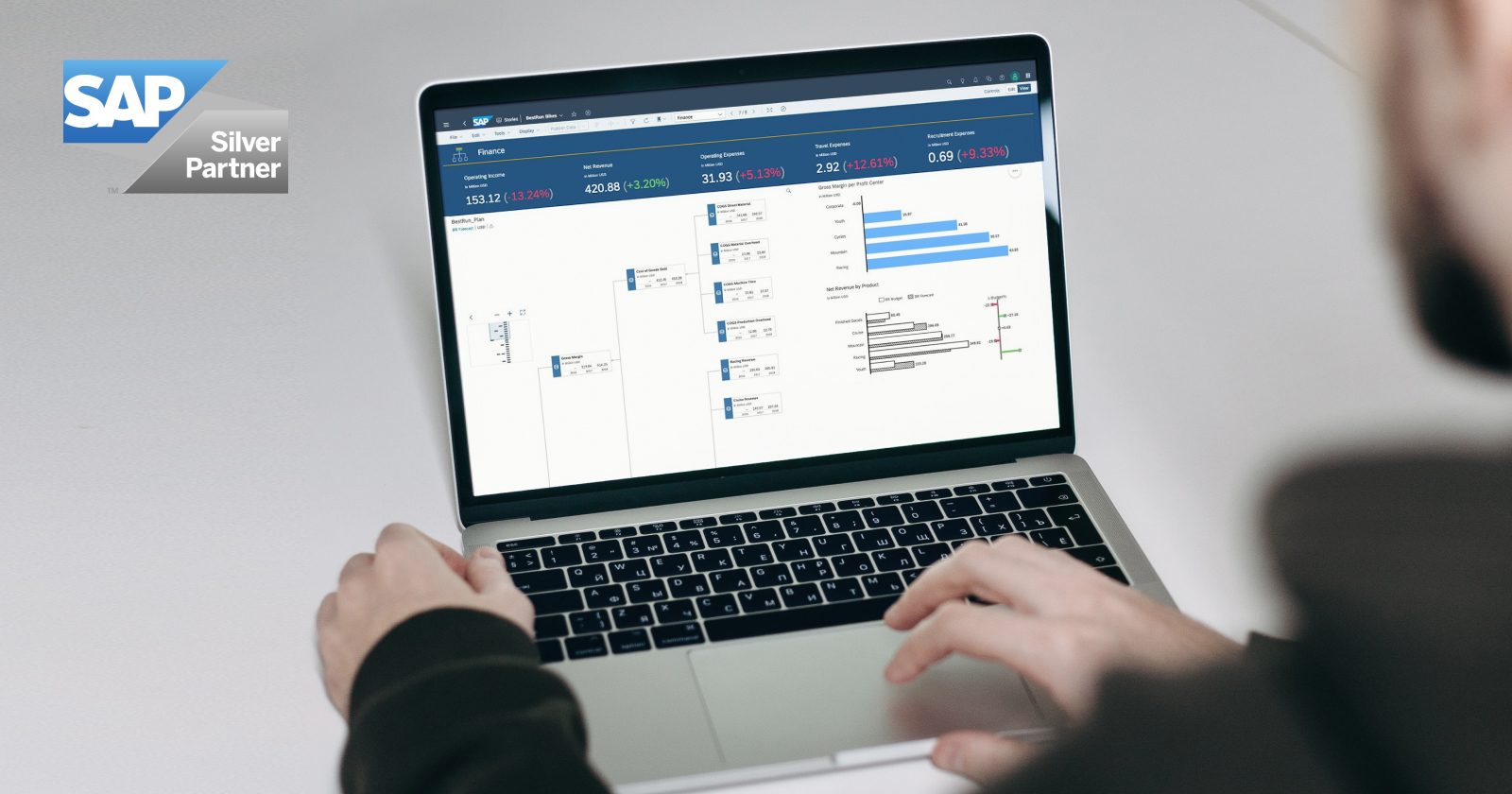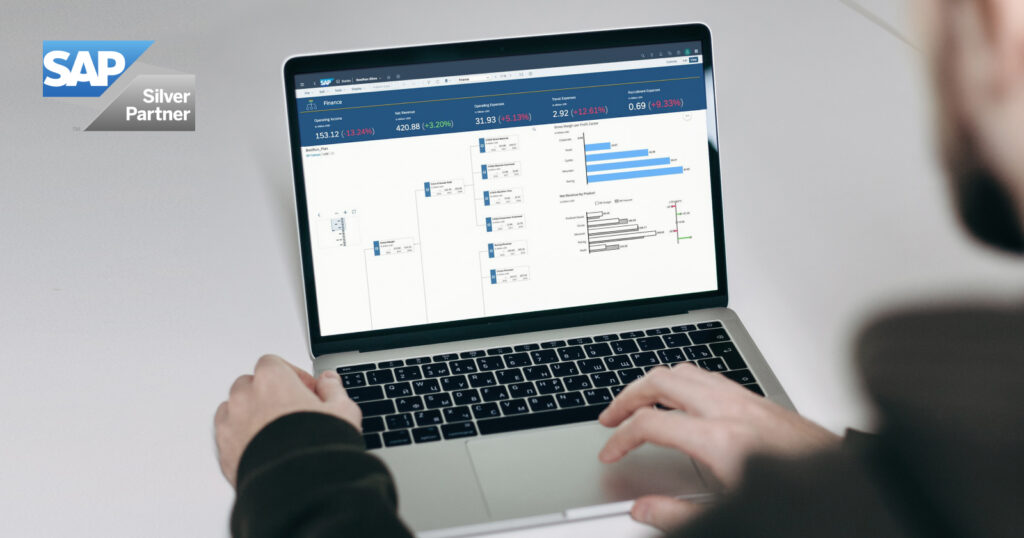Proekspert’s experience with SAP Analytics Cloud

How Proekspert minimized manual tasks and automated forecasting.
What is SAC and how did Proekspert end up using it?
Proekspert was the first Estonian company to use SAP Analytics Cloud (SAC), and we have the longest user experience in the entire region. We started about two years ago, and today all of our planning takes place in SAC.

Why did we choose SAC? SAP Analytics Cloud is a cloud-based 2-in-1 software service that contains both business analytics and budgeting tools. Budgeting is not definite planning from a financial point of view, but rather the testing and confirming of all kinds of forecasts, whether about finances, human resources, materials, and much more.
SAP Analytics Cloud is unique because it allows you to collect actual data from a variety of sources, analyze the data, monitor the implementation of budgets, and plan on the same screen. Data models need not be pre-set, i.e., the structure of the data is adaptable to the company’s needs and business logic, and the creation of the user interface is also very flexible. It is also possible to use the parts separately, either using business analytics on its own, or business analytics with the planning, and then implementing it step by step. Ready-made solutions can also be imported under SAP Business Content.
Proekspert’s experience and planning challenges
For Proekspert, planning is difficult due to the structure and complexity. We offer a lot of services and products, and several teams will work on a plan together.
Like many companies, we started planning with Excel. We had a single central Excel file that many people filled in. As you might expect, we had a lot of issues getting all the data together:
- Only one person could enter data at a time. Others had to wait.
- If a user forgot that the file was “open,” nobody else could continue working.
- Another user may not have noticed the read-only message, and the work could not be saved. Conflicting versions of the document emerged.
We also tried having everyone work in their own file, with data copied into a single file. This resulted in problems with copying formats and formulas, adding columns/rows.
It took a lot of time just to enter and correct the data. Moreover, it took away time from actual planning.
Planning with SAP Analytics Cloud
As with any great cloud solution, all users can work with SAP Analytics Cloud simultaneously. However, unlike with Office365 Excel, each user decides when to share their work with others. This avoids the misunderstandings of partially finished work (revenue entered, expenses not entered).
SAP Analytics Cloud key features are:
- Users can make their own versions to play with different scenarios
- Automatic data back-up
Today, Proekspert does planning without worrying about the availability of data; instead, we focus on creating and improving the plan. Since data management is easy, we have a budget and constantly-updated forecast available to everyone.
User involvement
Once upon a time, Proekspert’s plan was made centrally by one accountant. This plan was also better than nothing, but it lacked precision. Nor did anyone fully embrace the plan, and it could always be argued that the reason for not complying with the plan was that it had been made by someone else.
To improve the situation, we involved the heads of all departments in the planning process, so each could make their own plan and be responsible for its implementation. However, the involvement of many users created several challenges:
- Creating new user accounts: Who can access the applications?
- User rights management: Who can see what? Who can enter what?
- Using secure passwords
- Closing user accounts for employees who have left the company
With SAC, all user management is done through the Active Directory: there is one user account per employee for all tools, and employee access to SAC is managed centrally.
- Using SAC, we can manage viewing and editing rights for different user accounts.
- Single-sign-on for all services interfaces with the Active Directory, including SAC
- Password policy is set by Active Directory
A joint- and readable plan
Years ago, Proekspert was in a situation where all the right people had been involved in the planning, and data management problems had been solved. We were able to focus on actual planning. But then we immediately ran into another set of hurdles.
We did not understand why our plan ended up the way it did. Even if, in January, somebody knew why a plan was made, by the end of summer nobody could remember the particulars.
Proekspert’s joint plan is compiled as a profit-and-loss statement, with money as the common unit. Different departments plan their work in different units. For example, marketing plans on the basis of the number of clients and sales events. The number of clients determines the volume of customer gifts and the extent of the customer satisfaction survey. Meanwhile, the HR department focuses on the number of employees. The number of employees determines the size of company events, the training budget, occupational health visits, etc. As different departments have different planning logic, each department still makes its own plan in Excel. Only the monetary end result is included in the joint plan. However, that means it is not easy to understand in the joint plan why our revenue and expenditure figures are what they are. For example, you can tell what the share of marketing is, but you would not understand why it has to be that way. If you want to understand more, you have to ask the marketing department directly and look at the marketing unit’s Excel table.
Especially in situations where the plan includes fluctuating revenue and expenses, it isn’t easy to understand why some costs are so different during some months. Someone may certainly have a great explanation for it when drawing up the plan, but others cannot see it. And six months later, the planners themselves would not be able to remember why some expenses fluctuate so much.
What opportunities does SAC offer to address these challenges?
First, departments with different logic can have their own data models in SAC. For example, the data model of the HR unit allows planning based on the number of employees and employee-related expenses (volume of training per employee, volume of company events per employee, occupational health expenses per employee). Meanwhile, the marketing plan is based on the number of clients and its particular constants. This ensures that each department plans its activities in a language that the department understands. With such plans, the heads of specific departments no longer need their own Excel tables.
SAC can also combine data models created for different departments into one central model, which takes the financial part of each department’s model and consolidates the plans of all of these departments into one joint Proekspert plan. As a result, we now have the opportunity to see our joint plan and, if we wish, take a closer look at why the revenue or expenditure of a particular department has been planned to a certain extent. Thus, we can understand the plan a lot better.
SAC also allows for textual comments to be added to the data so that it is possible to understand, even much later, why a significantly different amount has been added to some cells. For example, suppose marketing costs are very high in a particular month. In that case, it is immediately possible to see that it may have been caused by several trade fairs happening in that month or, say, the website being translated into a new language.
SAC also allows you to have a conversation. For example, you can ask why some information is included in a particular way in SAC and you will receive the reply in SAC.
Analytics and data sources
The plan is done. Now, it would be great to know how we are actually doing. Are we moving toward our goals? Which parts of the organization are doing better, and which parts are doing less well?
To answer these questions, you first need data to compare to the plan. And second, you need an analytics tool to analyze the data.
SAC allows aggregating data from a variety of sources. Data can be imported manually, and databases and third-party applications can also interface with SAC.
At Proekspert, we have interfaced four data sources with SAC.
The main advantage of SAC is that it combines the tools for planning and analytics. We had previously been using one tool for planning and another for data analysis and visualization. Now, we can do it all with a single tool.
The possibilities for analysis are excellent.
Planning automation
No matter how reliable and convenient we make planning at Proekspert, it is still an extra task for most of our employees. It is a necessary task, but it is not anyone’s primary job. Employees would rather not do it at all.
Problem: Our plans only changed when someone changed them manually. At the same time, planning is not anyone’s main job here, so no one was in a hurry to update the plans. As a result, the forecasts tended to be a bit outdated, and we would often talk about actual changes in the office a fair bit earlier than these changes were also translated into monetary terms in the company’s joint forecast.
We have now begun to automate forecasting using all the data sources we have made available to SAC. For example, SAC can see who our employees are and how much they get paid via personnel records. SAC can also see in the resource planning application which employees have been scheduled for what periods and for what workload. Using this information, SAC can compile labor cost estimates for all our projects.
As the next step, we will also be automating revenue forecasting. Again, SAC has access to information about which employees have been booked for what jobs and the pricing model for each project. As most of our work is billed according to time and materials pricing, we also want to automate forecasting our main revenues based on this information.
In summary, interfacing various data sources with the planning application enables automating the planning process, and SAC also allows us to use the built-in capabilities for predictive forecasts.
Summary: the advantages of SAC for Proekspert’s planning processes
- The actual data and budget entry available in the same environment and the same form. Ongoing analysis of real data at the same time as monitoring budget implementation.
- Financial planning and resource planning, etc., in the same environment. Everything according to a structure that is defined as necessary.
- The ability to identify key indicators from past data and modify these to create future budgets.
- The opportunity to communicate in a chat window during the budgeting period.
- Appointing people responsible for certain parts of the budget. Budget scheduling, task assignment and automatic reminders.
- Interface with Excel user interface.
- Predictive analytics and its use in planning: the ability to forecast sales, reveal workforce thinning trends and much more. Using past data, it is possible to predict future trends and save these forecasts as budgets.
- Allocation and automatic data copying processes. Allocations are based on revenue, expenditure, amount of employees or other necessary proportions. Allocated aggregate sums can be transferred or copied between distributable units.
Proekspert – an SAP Silver Partner – has been active in the domain of business intelligence since 1998. First, as a BusinessObjects and Sybase partner, and since 2008, as an SAP Value Added Reseller.
Looking for a planning tool for your company and would like some further guidance? Please contact a member of the Proekspert team today.
About Proekspert
Proekspert is a skilled software development company with over 30 years of experience. We have encountered many diverse approaches to equipment, software engineering, and cybersecurity. Our expertise covers embedded software, device-cloud integrations, technician apps, and portals.









